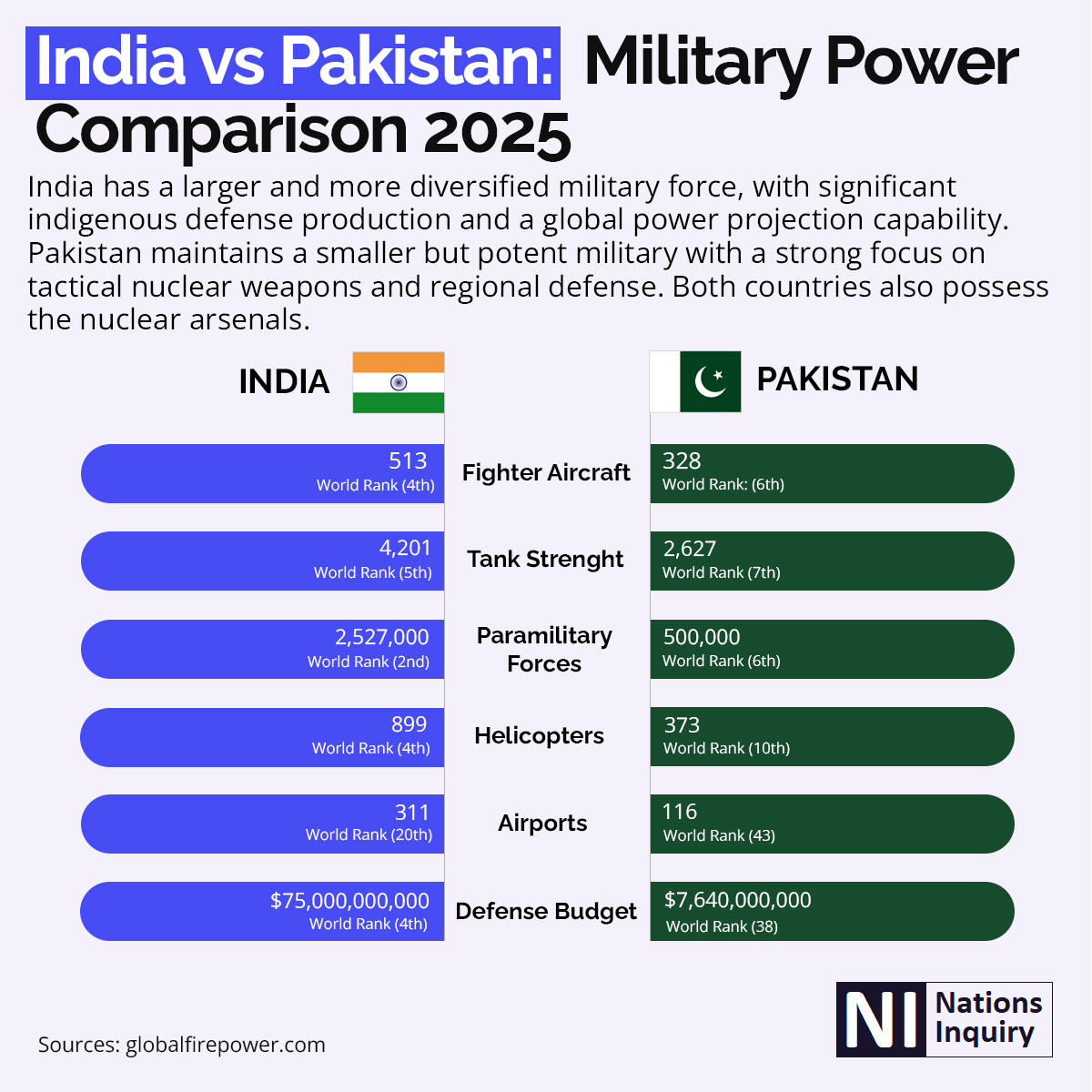The military rivalry between India and Pakistan continues to be one of South Asia’s defining strategic dynamics. Both countries maintain significant armed forces, shaped by historical tensions, border disputes, and evolving defense doctrines. As of 2025, India maintains a substantial edge in most conventional categories, though Pakistan continues to focus on asymmetric capabilities and regional alliances. Here’s a comparative analysis across key military parameters.

Fighter Aircraft
India has a much larger and more diverse combat aircraft fleet. As of 2025, the Indian Air Force (IAF) operates over 513 combat aircraft, including the French Rafale, Russian Su-30MKI, Mirage 2000, and indigenous HAL Tejas Mk1A. The induction of more Tejas Mk2 and AMCA prototypes is in progress.
Pakistan’s fleet, while smaller approximately 328 combat aircraft is highly modernized, with the JF-17 Thunder Block III (jointly developed with China) as its backbone. It also operates F-16s (supplied by the U.S.) and Chinese-origin J-10C fighters, enhancing its BVR (Beyond Visual Range) capabilities.
Paramilitary Forces
India has one of the world’s largest paramilitary forces, with 2,527,000 personnel across organizations like the Central Reserve Police Force (CRPF), Border Security Force (BSF), and Indo-Tibetan Border Police (ITBP). These forces play a critical role in internal security and border control.
Pakistan’s paramilitary strength is also considerable, with around 500,000 personnel in the Pakistan Rangers, Frontier Corps, and others. While smaller in size, these forces are well integrated with the regular military and often deployed in restive regions such as Balochistan and Khyber Pakhtunkhwa.
Tanks and Armored Vehicles
India fields around 4,201 main battle tanks (MBTs), including the Russian-origin T-90S Bhishma, T-72M1, and the indigenous Arjun Mk1A. Armored modernization is ongoing, with efforts to upgrade mobility and digital fire control systems.
Pakistan operates around 2,627 MBTs, with the Al-Khalid series being its most advanced. Many of its tanks are upgraded Chinese and Ukrainian models, and it continues to seek improvements in firepower and armor.
Helicopters and Air Mobility
India has significantly invested in rotary-wing platforms, operating a mix of over 899 helicopters, including attack variants like the AH-64E Apache, HAL Rudra, and the upcoming Light Combat Helicopter (LCH) Prachand. These assets provide air assault, reconnaissance, and close air support capabilities.
Pakistan’s helicopter fleet is smaller, around 373 units, with AH-1Z Vipers, Chinese Z-10s, and transport helicopters like the Mi-17. While numerically behind, Pakistan has prioritized multi-role flexibility and tactical mobility.
Military Airbases and Airports
India operates more than 311 operational military airports, strategically located across the country, including forward bases in Ladakh and the Northeast. The extensive infrastructure supports long-range missions and rapid deployment.
Pakistan has around 116 military airports, which are well distributed across its territory. While fewer in number, they are strategically placed to cover all major fronts with India.
Defense Budget
India’s defense budget for 2025 is approximately $75,000,000,000 making it the third-largest in the world. A significant portion is allocated toward modernization, indigenous defense production, and new-age technologies like cyber and space warfare.
Pakistan’s defense budget stands at around $7,640,000,000. Although smaller, it prioritizes nuclear deterrence, border security, and selective modernization through Chinese collaboration and strategic partnerships.
Strategic Outlook
India’s focus is on building a self-reliant and technologically advanced military force with global reach. Pakistan, on the other hand, emphasizes strategic deterrence, tactical mobility, and regional alliances, particularly with China.
In conclusion, while India holds numerical and technological advantages in most conventional categories, Pakistan’s agile and focused approach ensures that it remains a formidable adversary. The military balance remains sensitive, with diplomacy and deterrence being as critical as weapons in maintaining regional peace.
